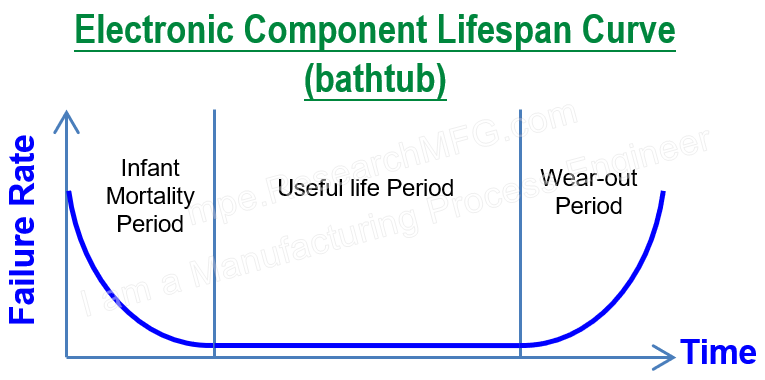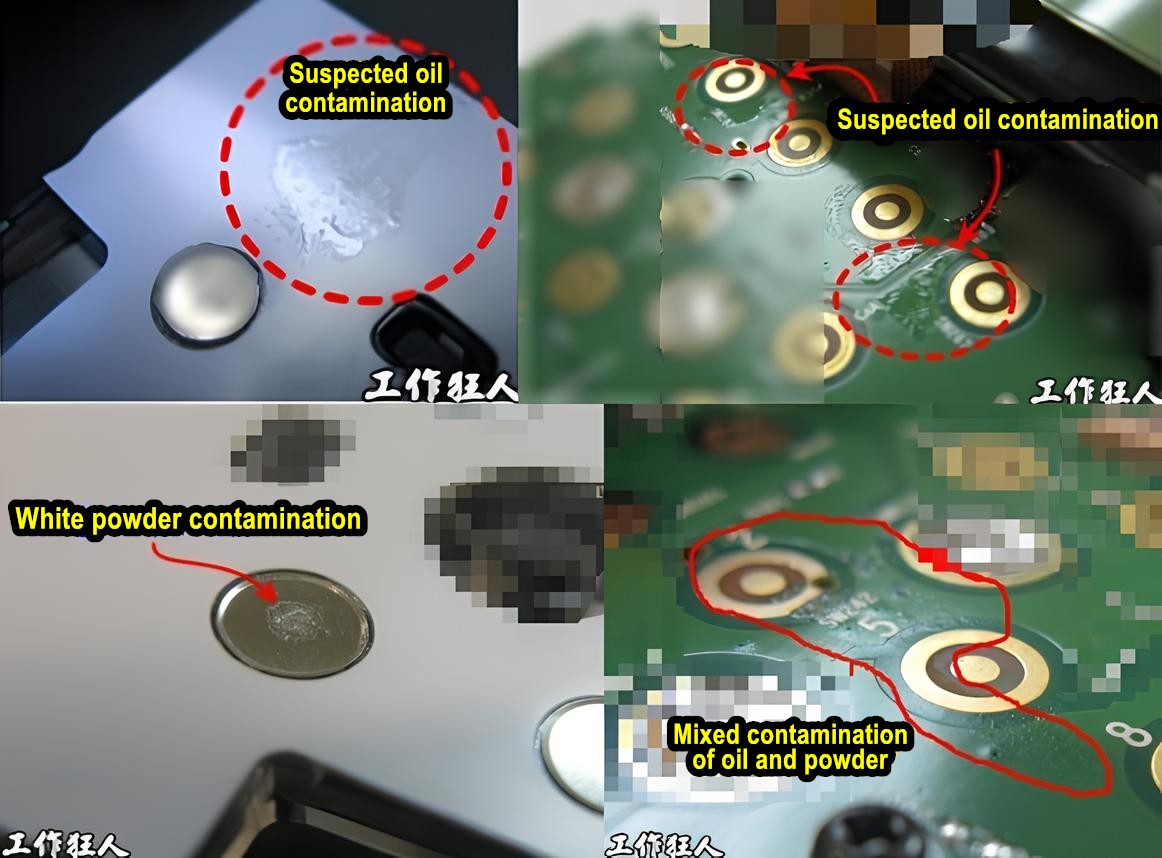
In the early days, when electronic component design and manufacturing were still developing, the “burn-in” solution was used to screen out defective electronic components and products. This process allowed early-failing products to be identified and eliminated, preventing defective items from reaching customers and causing complaints. Statistical data shows that the lifespan of a batch of electronic products typically forms a “bathtub curve.” This means that there are higher rates of defective components at the beginning and end of their usage, but after a period of use, the defect rate drops to a near-zero stable state, resembling the shape of a bathtub curve.

Suggested Further Reading: What is Environmental Stress Screening (ESS)?
However, after decades of development, the electronics industry has almost become a traditional industry. Nowadays, most electronic components have stable reliability and longevity, and early failures are rarely heard of. Therefore, whether to continue implementing burn-in testing is a challenging issue for the electronics assembly industry. Many electronics assembly plants have debated whether to perform burn-in testing for their products, and most of these debates remain inconclusive.
Discussions in Workingbear’s Company
Workingbear’s company often debates this issue. Almost every time a new boss takes over, this topic is revisited for discussion. Before deciding whether to implement or cancel burn-in testing, it’s essential to understand what burn-in testing (B/I) is, its advantages and disadvantages, and whether your products still need burn-in testing.
What is Burn-In?
Burn-in is a process where products are placed in a “Burn-In room” with controlled temperature, usually around 40°C ± 5°C. Theoretically, the temperature should be as high as possible to screen out more defective products, but it must not exceed the product’s tolerance. Generally, if engineering plastics are exposed to temperatures above 60°C under stress, they may deform. The 40°C setting also considers the impact of internal heat generation within the product.
During burn-in, power on/off tests are typically conducted simultaneously. Electronic products often experience a surge in current when powered on, similar to the initial force of a dam releasing water. This surge can easily exceed the design limits set by electronic engineers, testing both their skills and the quality of electronic components. However, with recent advancements in voltage regulation components and improved circuit designs, such issues have become less common.
Burn-in is usually performed after the product assembly is completed. Products undergo another full test after burn-in before shipping to screen out any defects caused by the burn-in process. The burn-in environment and conditions are crucial. The product should be powered on and off in cycles, with the environment temperature controlled. Ideally, the program should continuously run through all functions during burn-in.
Here’s the general production process and steps:
Product Assembly + Initial Testing → Burn-In → Final Full Testing + Packaging → Shipping
Advantages of Burn-In for Electronic Products
-
Burn-in can screen out early failures of components and products.
This is based on early theories, as mentioned earlier. Nowadays, electronic components are highly reliable, and early failures are rare. However, burn-in can still identify issues like cold solder joints, De-wetting, and Non-wetting in the production process. Additionally, burn-in can help avoid purchasing from suppliers with inconsistent quality, as low prices often come at the expense of quality. -
Burn-in can further ensure the quality of shipped products.
Different batches or brands of components may have compatibility issues. Burn-In testing can help identify these issues. Additionally, for PCB assembly with BGAs that are prone to HIP/HoP (Head-in-Pillow) defects, performing relevant functional tests during Burn-In greatly increases the chance of detecting these defects. -
Burn-in gives engineers more time to identify product instability.
When new products enter mass production, their quality is often less stable. Burn-in provides production line engineers extra time to adjust and fine-tune the products to achieve optimal quality.
Disadvantages of Burn-In for Electronic Products
-
Burn-in requires additional space and power to accommodate the products, increasing facility costs.
-
Burn-in takes extra production time, reducing the efficiency and turnover rate of shipping.
- Burn-in requires extra manpower for setup, wasting labor costs.
Despite these pros and cons, the key factors in deciding whether to perform burn-in are quality and, inevitably, money—both tangible and intangible costs. The choice is between catching most product issues before shipping (tangible cost) or dealing with customer complaints later (intangible cost). Some managers may gamble by eliminating the burn-in process to save visible costs, treating customers as quality assurance. If issues arise after the product reaches the market, the decision-makers might have already moved on, leaving the remaining engineers to handle the fallout.

To protect ourselves, we engineers insist on the necessity of burn-in but have devised a gradual reduction method. Initially, products undergo 24-hour burn-in at 100% during mass production. As product yield improves, the 24-hour burn-in is reduced to 4 hours, eliminating pre-burn-in testing together. When the quality reaches an even higher level, we switch to a 10% sample size burn-in for 4 hours.
We agreed to reduce burn-in time to 4 hours because our company’s quality data showed that most defects during burn-in occurred within the first 4 hours. Be noticed that each company’s product characteristics vary, so this may differ. Some products may show issues within 2 or 1 hour, while others may need longer.
Sampling size burn-in has a significant drawback: if the defect rate exceeds the standard during burn-in, how should the entire batch be handled? How can defective products be recalled? This is a major challenge. Should production revert to 100% burn-in and then reduce to 10% once stable? Burn-in room capacity might become another issue.
We also aim to have products automatically test all functions during burn-in, keeping records to reduce unnecessary testing time post-burn-in, thereby maintaining burn-in while lowering labor hours.
What is “Run-In”? How Does It Differ from “Burn-In”?
Some factories use “Run-In” instead of “Burn-In.” So, what is “Run-In”? “Run-In” is somewhat similar to warming up a car. Typically, after assembly, the product is powered on to ensure it works, then left to run for a while (like “letting the bullet fly”). This could be for 30 minutes or 60-120 minutes. Some production lines even let products ascend and fly around the factory, similar to TSMC’s overhead wafer transport, to avoid occupying factory space. After a lap, the product returns to the production line for further testing, inspection, and packaging.
The main difference between “Run-In” and “Burn-In” is temperature control. “Burn-In” generally defines an environment temperature, such as 40°C ± 5°C, which should not exceed the product’s tolerance, usually the deformation temperature of plastics. “Run-In,” however, does not specify an environment temperature, usually occurring at room temperature, which can vary significantly depending on the location an weather.
Strictly speaking, “Burn-In” is more rigorous than “Run-In.” As for the effectiveness of “Run-In,” Workingbear suggests testing a few batches and analyzing the data before deciding, as outcomes can be unpredictable.
Related Posts:






Leave a Reply